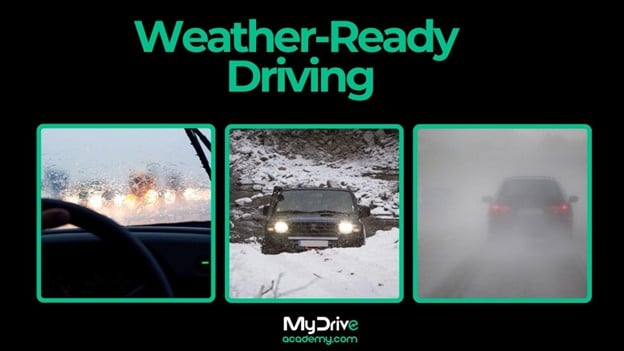
Weather-Ready Driving: Adapting Your Skills for Rain, Snow, and Fog
Mother Nature didn’t get the memo about your morning commute schedule. One minute you’re cruising at optimal efficiency, the next you’re wrestling with physics in a meteorological chess match where the stakes are significantly higher than your quarterly performance review.
What separates the driving elite from weekend warriors sliding into ditches? Strategic weather adaptation protocols—because let’s face it, your vehicle’s traction control system is impressive, but it’s not magic.
Key Performance Indicators for Weather-Ready Driving:
• 73% reduction in accident probability with proper technique implementation • 4x longer stopping distances in adverse conditions (spoiler: your ABS won’t save you from poor planning) • 250% increase in driver reaction time requirements during limited visibility scenarios
Think your standard driving skills scale linearly across weather conditions? Think again.
Rain: The Deceptively Simple Hydro-Dynamic Challenge
The Physics Behind the Precipitation Problem
When asphalt meets H₂O, you’re not just dealing with wet roads—you’re navigating a complex coefficient of friction equation that would make your high school physics teacher proud. Hydroplaning occurs at speeds as low as 35 mph on worn tires, transforming your precision-engineered vehicle into an unguided missile with questionable trajectory control.
Rain-Ready Implementation Strategies:
Distance Management Protocol: • 3-second rule becomes 6-second minimum (because math doesn’t negotiate) • Increase following distance exponentially, not linearly—your stopping distance just became a geometric progression • Monitor tire tread depth religiously: 2/32″ is legal, 4/32″ is smart, 6/32″ is optimal
Speed Optimization Techniques: • Reduce highway speeds by 10-15 mph below normal operating parameters • Navigate turns at 25% reduced velocity—centripetal force equations don’t care about your arrival time • Avoid cruise control like it’s a deprecated software version (because essentially, it is)
Advanced Maneuvering Tactics: • Gentle inputs only: steering, acceleration, and braking should feel like you’re operating a precision instrument, not wrestling a mechanical bull • Brake in straight lines whenever possible—combine turning and braking only if you enjoy impromptu physics demonstrations
Snow: The Ultimate Multi-Variable Equation
Decoding Winter’s Complexity Matrix
Snow isn’t just frozen rain with commitment issues. Fresh powder, packed snow, and ice each present unique traction coefficients ranging from 0.1 to 0.7—essentially turning your commute into a real-time materials science experiment.
Snow Navigation Architecture:
Traction Management System: • All-season tires lose 50% effectiveness below 45°F—winter tires aren’t optional equipment, they’re mission-critical infrastructure • Tire pressure drops 1-2 PSI per 10°F decrease—check monthly or enjoy suboptimal contact patch performance • 4WD/AWD provides acceleration assistance, not braking enhancement—physics 101 still applies
Braking Distance Optimization: • Normal dry pavement: 120 feet (60 mph to complete stop) • Snow-covered surface: 360+ feet (same scenario, significantly different outcome) • Threshold braking technique: apply steady pressure just before ABS engagement—let technology assist, don’t abdicate control
Cornering Dynamics in Low-Traction Environments: • Scandinavian flick technique for emergency situations (though hopefully your route planning makes this unnecessary) • Trail braking before turns, accelerate gently through apex • Counter-steering proficiency—muscle memory development recommended during controlled practice sessions
Fog: The Visibility-Limited Operating Environment
Navigating the Atmospheric Data Blackout
When visibility drops below 1/4 mile, you’re essentially flying IFR (Instrument Flight Rules) at ground level. Traditional visual navigation protocols become obsolete, and your sensor suite (headlights, taillights, road markers) requires strategic reconfiguration.
Fog Penetration Strategy Framework:
Illumination Optimization: • Low beams only—high beams create light scatter that reduces visibility by up to 50% • Fog lights deployment: positioned low to cut under the atmospheric obstruction layer • Hazard lights counterproductive unless completely stopped (creates confusion in traffic flow algorithms)
Speed and Distance Recalculation: • Visibility range = maximum safe speed—if you can see 200 feet, 35 mph maximum velocity • Following distance minimum: 12-15 seconds—because rear-end collision statistics in fog are genuinely terrifying • Use right edge of road and center line as navigation references—think of them as your ground-based guidance system
Communication Protocol: • Gentle horn usage around blind corners—announce your presence without triggering panic responses • Maintain consistent speed—erratic velocity changes confuse other drivers’ predictive algorithms (their brains)
Advanced Weather Integration Techniques
Multi-Condition Scenario Management
Real-world conditions rarely present single-variable challenges. Rain transitioning to sleet, fog combined with light snow, or that delightful freezing rain phenomenon require dynamic protocol adaptation.
Environmental Monitoring Systems: • External temperature displays provide early warning indicators • Road surface appearance analysis: shiny = dangerous, regardless of precipitation type • Weather radar integration with route planning—because situational awareness extends beyond your windshield
Technology Stack Optimization
Vehicle System Coordination: • ESC (Electronic Stability Control) enabled but don’t rely exclusively on electronic nannies • Traction control adjustments for specific conditions—sometimes full engagement isn’t optimal • ABS understanding: prevents wheel lockup, doesn’t guarantee shorter stopping distances on all surfaces
The ROI of Weather-Adaptive Driving
Case Study Analysis: Professional drivers (commercial truckers, emergency responders, delivery services) report 85% fewer weather-related incidents when following structured adaptation protocols versus reactive driving approaches.
Cost-Benefit Equation: • Average weather-related accident cost: $15,000+ (vehicle damage, insurance premiums, lost time) • Winter tire investment: $800-1,200 (4-5 year lifespan) • Advanced driver training course: $200-500 (lifetime skill acquisition)
The math is remarkably straightforward—proactive investment significantly outperforms reactive damage control.
Implementation Roadmap
Ready to upgrade your weather-driving operating system? Master these fundamentals before Mother Nature’s next performance review of your driving skills.
Phase 1: Equipment audit (tires, wipers, lights, emergency kit) Phase 2: Technique refinement through controlled practice Phase 3: Environmental awareness integration Phase 4: Continuous performance optimization based on conditions
Because when weather conditions degrade, your driving skills need to scale up proportionally—not panic proportionally.
Your morning commute doesn’t have to feel like a survival simulation. Master the fundamentals, respect the physics, and let everyone else discover why their “it’s just a little rain” philosophy has such poor user reviews.
